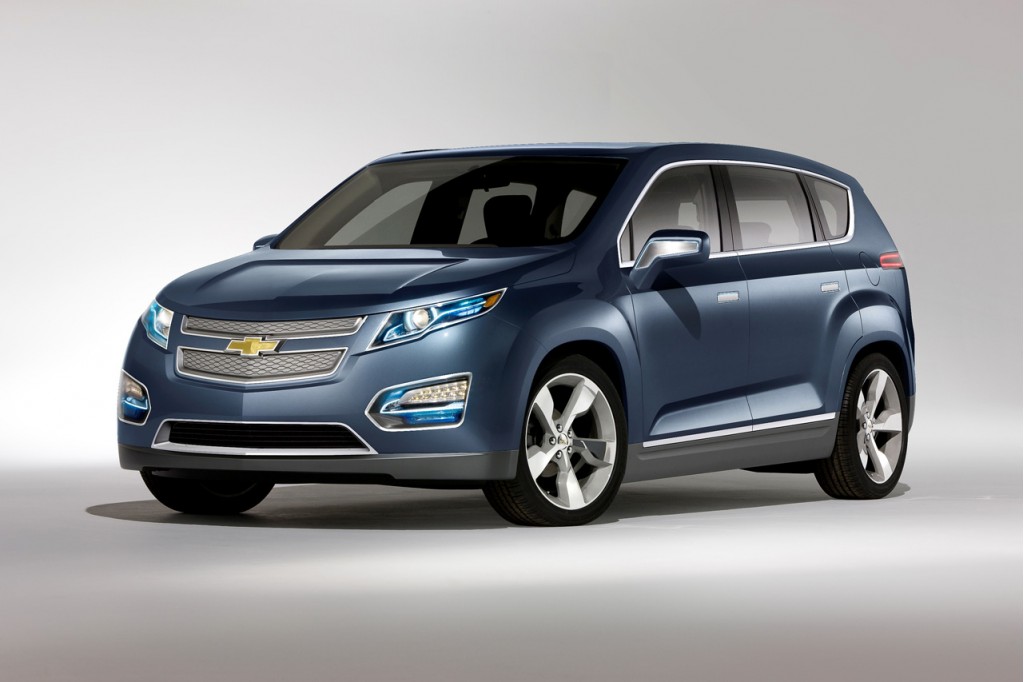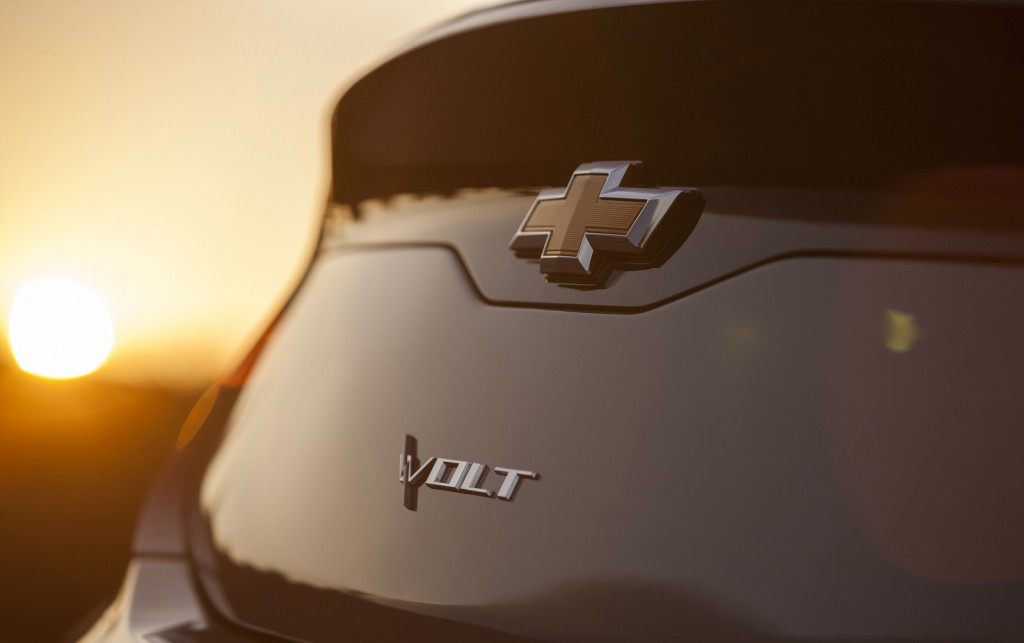
2016 Chevrolet Volt sneak peak for owners, Los Angeles, Nov 2014
For most of 2014, there was very little news about the Chevrolet Volt range-extended electric car, and its sales in 2013 and 2014 have been stagnant at roughly 2,000 cars a month.
The most recent item of note was a $5,000 price reduction on the 2014 Volt in August 2013, to bring it closer to the center of the volume-car market, along with a battery-pack upgrade for the 2015 model.
But behind the scenes, Chevrolet has been busy preparing the next iteration of its pioneering plug-in car.
Based on published articles, a host of private conversations with industry analysts, electric-car advocates, and--yes--a few General Motors employees, here's what we know so far about the next Volt.
[EDITOR'S NOTE: We first published this article in March 2014. As the debut of the 2016 Volt approaches, Chevy has released selective details, including a peak at the front styling, some charging updates, and an overview of the powertrain.
This article has been updated to reflect that new information. For all the latest updates on the 2016 Volt, see our Chevrolet Volt news page.]

First 2011 Chevrolet Volt delivered to retail buyer Jeffrey Kaffee, in Denville, NJ, December 2010
TIMING and COST
GM will unveil the redesigned 2016 Chevrolet Volt at next January's Detroit Auto Show.
The main reason for redesigning the Volt is to get the cost down. Way down.
Departed GM CEO Dan Akerson said a number of times that the goal for the next model was to take $10,000 in cost out of the Volt.
ALSO SEE: Next Chevy Volt $10,000 Cheaper To Build, Profitable For GM?
We don't have confirmed numbers on what today's Volt costs to build, but Akerson himself admitted last May that GM loses money on each one.
Will the new car be profitable? If GM follows the same model as Toyota did with its Prius hybrid, a second-generation Volt might turn profitable sometime during its model cycle.
More important to consumers, we suspect that Chevy will keep the price at $35,000--and may cut it further.

2016 Chevrolet Volt powertrain
Our ideal target would be $29,995--and, remember, the new Volt will still qualify for a $7,500 Federal income-tax credit plus various state and local incentives.
But GM may well keep the 2016 Chevy Volt at around $35,000, as a premium offering. Or it could offer a lower base price, but a wider selection of options to bring the price back up.
We'll have to wait for that one.
ELECTRIC RANGE
It's safe to say that a much longer electric range may be the top request for the new car from owners of the current Volt.
Chevrolet says, however, that the 2016 Volt will have a slightly higher range. Effectively, GM is sticking with its original 40-mile range.

2016 Chevrolet Volt powertrain
(The 2011 Volt was rated at 35 miles of range, which rose to 38 miles for 2013 and later models.)
As GM has said for many years now, almost four-fifths of U.S. vehicles travel 40 miles a day or less--which means that greater electric range applies to a smaller and smaller proportion of vehicles and uses.
Today, GM says Volts cover almost two-thirds of all their miles driven on grid electricity used to charge their battery packs--and 80 percent of all commute miles--with the gasoline range extender only used for the remainder.
Moreover, the goal of radically cutting the Volt's build cost argues against adding any range. GM needs to make its battery pack smaller and much less expensive to get there, so we'd lay money on keeping the current 40-mile electric range.

2011 Chevrolet Volt MPV5 concept, Unveiled at 2010 Beijing Motor Show
BODY STYLE(S)
The current Volt is a compact five-door hatchback, and we expect the new 2016 Volt to retain its dedicated shape.
Just as for two generations of Toyota Prius, the high vertical tail of the Volt is the best way to cut the energy used to overcome aerodynamic drag at 30 mph and higher.
But today's Volt has just four seats. There's no central rear seating position because the T-shaped battery pack that runs down the car's center tunnel gets in the way.
That missing fifth seat has turned out to be a deal-breaker for some buyers who'd otherwise love to have a Volt, and GM knows this.
While it hasn't been confirmed, rumors from Volt owners who attended a preview event in Los Angeles during November's auto show indicate that at least some provision for a fifth seating position has been made.
2013 Chevrolet Volt
Whether the new Volt battery pack can be redesigned, rearranged, and repackaged to permit a fifth seat isn't known now--but we're betting it's one of the top program goals.
Rumors of two different versions of the 2016 Volt, however, were firmly denied by the Volt project team during the powertrain preview.
While many Volt owners say they want a five-seat "tall Volt," closer in format to today's Ford C-Max, like the Volt MPV5 Concept shown in China in April 2010, that doesn't appear to be in the cards, at least right away.
We think GM has to sell many more Volts a year in the basic model before it considers any additional body styles.

2013 Chevrolet Volt - Driven, December 2012
STYLING
Like its lines or not, the Volt today has become a recognized shape.
According to Edmunds, the designers will evolve that shape rather than replace it--though it will now be built on top of GM's new Delta 2 compact-car architecture.
Those underpinnings will be used for the upcoming 2016 Cruze compact sedan, and many other models to follow.

2016 Chevrolet Volt sneak peak for owners, Los Angeles, Nov 2014
We'd like to see a taller window line and more side glass, eliminating the hokey black-plastic panels that visually lower what are actually quite short side windows.
Or as one GM body designer told us, the Volt looks the way it does because it's essentially a Chevy Cruze firewall and crash structure with a roof chopped 4 inches.
DON'T MISS: 2016 Chevy Volt: Front Styling Teaser Photos, Charging Details Released
Last month, however, GM released a few teaser shots of the 2016 Volt, which followed an artful shot of the new tail released in late summer.
We'll see the rest of it in January.

2016 Chevrolet Volt - first teaser image, Aug 2014
Regardless of what we want, however, expect the next Volt to have a recognizable shape evolved from today's car.
We're betting it'll also have LED running lights and possibly even headlights.
Not only have they appeared on many large trucks and sport utility vehicles from GM, they're now found on the Cadillac ELR range-extended electric luxury coupe that shares Volt technology.

2016 Chevrolet Volt powertrain
BATTERY TECHNOLOGY
GM will likely stick with its existing lithium-ion cells from its current battery partner, LG Chem--though refinements to chemistry and production technology could well increase the energy capacity of each cell.
But Voltec engineers may also be able to use more of the battery's pack total energy capacity, known as "opening up" the pack's state-of-charge range.
Today's Volt has a battery pack of 16.5 kilowatt-hours, of which it uses only 10.8 kWh--or 65 percent.
That's a sensibly conservative amount, and gives GM a healthy margin to ensure battery life in older Volts. But it's also lower than the usage in many other plug-in electric cars, especially battery electrics.

2016 Chevrolet Volt sneak peak for owners, Los Angeles, Nov 2014
GM says it will use higher-capacity cells, but it has cut the number of cells in each 2016 Volt's battery pack from 288 to 192, reducing complexity.
If it can use a greater percentage of the pack's overall energy--70 or 75 percent, perhaps--it could significantly reduce the pack size and weight. Indeed, the new pack is 30 pounds lighter.
MORE: 2016 Chevy Volt: Bigger Battery, More Motor Power, New Range Extender Engine Details
As of now, Voltec engineers have far more data--five years or more--on how Volt batteries age than they did on launch.
That means they will be far more confident that using a bit more of the total capacity wouldn't risk unacceptable capacity loss down the road.

2016 Chevrolet Volt powertrain
RANGE EXTENDER
One thing that will change in the next Volt is its range extender.
While many expected it to be a variation of the 1.0-liter turbocharged three-cylinder engine that was launched a year ago in the Opel Monza concept at the Frankfurt Motor Show, it wasn't.
Instead, GM is fitting a special variation of its new 1.5-liter four-cylinder engine from the same family to replace the current 1.4-liter four producing 85 hp. The outgoing engine was adapted from a 138-hp 1.4-liter turbo fitted to the Chevrolet Sonic subcompact and Cruze compact sedan.
The goal of using a slightly larger engine, which has been optimized to run on the ultra-efficient Atkinson Cycle under certain circumstances, is to reduce noise and vibration considerably and provide enough power so the 2016 Volt isn't strained under maximum power demand.
The new engine is lighter than the old one, and along with power electronics integrated onto the top of the Voltec transmission, overall vehicle weight could fall substantially.
While Chevrolet has only released a few selected specifications thus far, the combination of new battery and engine might boost the 2016 Volt's gas mileage in range-extending mode from today's 37 miles per gallon to 40 mpg or higher.
For more details on the engine, battery, electric motors, and power electronics, see the link above.

2016 Chevrolet Volt teaser image, with GM marketing chief Tim Mahoney, Aug 2014
WISH LIST
Many of today's Volt owners are expecting all specifications to improve. Some suggest that "triple fives" are the appropriate goal for GM to target: 50-mile electric range, 50 miles per gallon in range-extending mode, and five seats.
We suspect that GM is far more interesting in producing a Volt that's lighter, more capacious, and considerably cheaper to build.
If the company can turn a profit by selling Volts--which it isn't today--then it becomes possible to pay for a lot more innovation in an all-new Volt in, say, 2020.
Meanwhile, we should know much more about the 2016 Chevrolet Volt in about a month.
It's better than the 10-month delay when we published the first version of this article, but the wait seems like a very long time, doesn't it?
_______________________________________________













